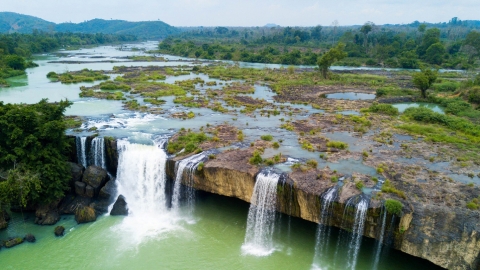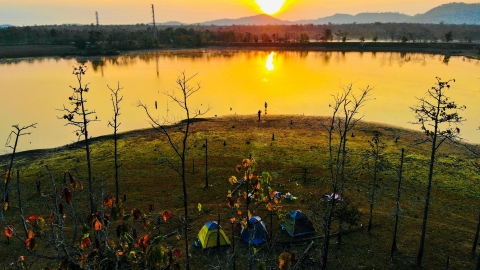Long house shape in the middle of the street
In the middle of modern Buon Ma Thuot streets, Dak Lak Museum appears like a giant Ede longhouse rising on the red basalt soil. From afar, the high curved roof recalls the shape of a traditional stilt house, while the glass reflects the sunlight, making the building exude a modern, gentle look amidst the green, tree-lined campus.

Dak Lak Museum's appearance from the outside

The museum's green, tree-lined campus
The museum was started in 2008 and inaugurated in 2011, the result of cooperation between the Vietnam Museum of Ethnology and French experts. With an area of over 9,000 m², this is one of the largest cultural works in the Central Highlands. The architecture here is not only to be seen, but also to feel, because in every detail there is a harmony between tradition and contemporary, between the majesty of the mountains and forests and the creative spirit of humans.
Passing through the large gate, one seems to leave the hustle and bustle of the city. Before one’s eyes is an open courtyard, where the shade of ancient trees is shady, the wind carries the scent of wood, soil and coffee. From that moment, the journey to explore the museum begins - a journey through three regions of memories of the land and people of Dak Lak.

The museum facade seen from the main gate is trapezoidal, two stories high.
National cultural space - Breath of the mountains and forests
The door opens, and the first thing that greets visitors is the sound of gongs echoing somewhere. In the warm yellow light, the Ethnic Culture Space appears like a vivid picture of the lives of 49 ethnic groups living on this land.

Ethnic cultural space is a place to learn about the culture of ethnic minorities in the Central Highlands.


On the walls, pictures of buffalo stabbing festivals, new rice celebrations, or Ede women weaving brocades continue to tell an endless story. In the middle of that space, woven bamboo baskets, jars of rice wine, patterned loincloths, silver jewelry, dugout canoes, etc. are arranged as if their owners had just left for a moment. Each item bears the mark of human hands, soaked in sweat and the rhythm of mountain life.


Another corner recreates the Ede long house - a communal house of many generations. When entering, the smell of old wood and ancient kitchen smoke still lingers. One can imagine the sound of children playing, the high and low voices of Khan by the fire, or the sound of gongs in harmony during the festival night. Every small detail from the weaving loom to the bamboo flute and bronze gong all contribute to reviving a pristine, warm and vibrant Central Highlands.

A corner recreating the long house and working tools of the Central Highlands people


Historical space - Flow of memories
Leaving the warmth of the long house, visitors step into the Historical space, where the light is dimmed, allowing silence to prevail. Here, black and white photos, tools, weapons and documents are arranged like a flow of time connecting the past with the present.
From the early days, when humans first found their footprints on the highlands, to the period of resistance against the French and the Americans, every milestone is vividly recreated. Steel helmets, ancient guns, marching maps, soldiers' handwritten letters, or items of people in the war zone - all carry within them the story of the resilience and patriotism of the people of the Central Highlands.


Historical space provides information about the formation and development of this highland.
The large wall at the end of the room is a series of images of Buon Ma Thuot during the war years: houses destroyed by bombs, people still steadfastly defending their land. Next to it is a corner recreating the day of Buon Ma Thuot's liberation in 1975 - a historical milestone that opened the great victory of Spring. Standing before these photos, people feel not only the pain and loss, but also the burning pride of the land that once struggled in the fire and smoke.

Historical relics from ancient times are preserved in the museum.


Biodiversity Space - Song of the Green Forest
Stepping into the Biodiversity space, the space suddenly opens up and is filled with light. It feels like leaving the harsh history to return to the vast nature. Here, animal and plant specimens, photos of Yok Don forest, Lak lake, Dray Nur waterfall, Dray Sap... create a majestic picture of Dak Lak's nature.



This area introduces information about plants, including coffee - the staple bean of Buon Ma Thuot.
In the middle of the large room, a model of a primeval forest was erected, recreating the typical ecosystem of the Central Highlands: from the tall trees, the bushes to the dry leaf carpet. Next to it, the bird display area left everyone amazed: eagles, peacocks, red-crowned cranes, and precious animals such as elephants, gaurs, and leopards. Each creature is an indispensable part of the forest life cycle - where humans and nature are closely connected and depend on each other.

The biodiverse space makes visitors feel like they are lost in a primeval forest.
Parallel information panels on conservation and sustainable development remind viewers that without forests and rivers, the Central Highlands would no longer be the Central Highlands. And perhaps, that message is what makes this exhibition so moving - a gentle invitation for everyone to keep their love for nature.
As the afternoon fell, pale yellow sunlight filtered through the curved roof of the museum, shining on the dark wooden stairs. Outside, the wind still blew through the trees, carrying the scent of soil, wind, and coffee in the air. That was when people realized: this museum not only preserved artifacts - but also preserved the soul of a land, where the past and present intersected in the same breath.

Exhibition area of photos about the cultural beauty of ethnic groups in Dak Lak
Dak Lak Museum is not noisy, not flashy, but every person who has been there brings back something, maybe the impression of the long house architecture, the sound of gongs, or simply the feeling of peace when sitting in the middle of the campus, listening to the sound of the forest wind blowing through the ears. And perhaps, that is why this place is always called by a simple but profound name: the story-telling house of the Central Highlands.




































